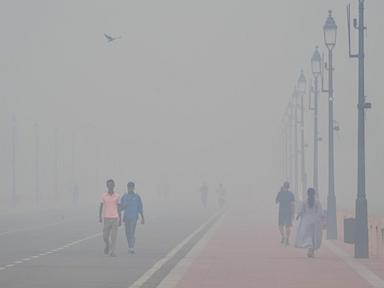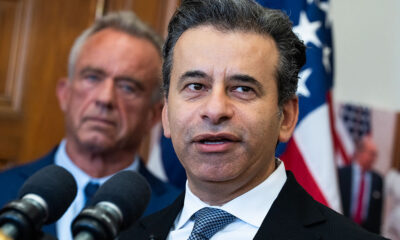World
New Delhi Faces Hazardous Air Quality Post-Diwali Celebrations

New Delhi experienced a severe decline in air quality following the celebrations of Diwali, the Hindu festival of lights, which took place on November 12, 2023. Millions of revelers filled the night sky with fireworks, resulting in an alarming spike in air pollution levels. By the morning of November 13, the city’s Air Quality Index (AQI) exceeded 350 in several neighborhoods, categorizing it as “severe” and posing significant health risks, according to the World Health Organization’s guidelines.
The celebratory firecrackers released smoke and fine particulate matter into the atmosphere, compounding existing seasonal pollution and stagnant weather conditions. Visibility diminished throughout the city, shrouding streets and historical landmarks in a thick gray haze. “I have never seen anything like this before. We can’t see anything here because of pollution,” remarked Vedant Pachkande, a tourist visiting New Delhi.
Regulatory Challenges and Environmental Impact
In a bid to address the pollution issue, India’s Supreme Court had recently modified a comprehensive ban on firecrackers in New Delhi. The ruling permitted the limited use of “green firecrackers,” which are engineered to produce around 30% less pollution compared to traditional firecrackers. These were allowed during designated hours from November 11 to November 14, but enforcement of these regulations remained lax, similar to previous years.
New Delhi, along with its metropolitan area, is home to over 30 million residents and consistently ranks among the world’s most polluted cities, particularly during winter months. This period coincides with increased firecracker usage during Diwali and the burning of crop residues in nearby states. Despite measures implemented by local authorities, including restrictions on construction activities and diesel generator usage, environmental activists argue that more sustainable solutions are essential. Cleaner energy sources and stringent vehicle emission controls are critical to mitigating ongoing air quality crises.
Sunshine Decline Linked to Rising Pollution Levels
A recent study published in Scientific Reports highlights a troubling trend: rising air pollution has been linked to a significant reduction in the number of sunshine hours across most of India. The research, conducted by scientists at Banaras Hindu University, found that increasing levels of aerosols—tiny particles released from industrial activities, biomass burning, and vehicle emissions—are responsible for this decline.
Manoj K. Srivastava, a scientist and one of the study’s authors, noted, “We see a greater impact in more polluted regions such as northern India.” The reduction in sunlight not only affects solar energy generation but also poses risks to agricultural productivity and public health.
As the situation in New Delhi underscores the urgent need for effective air quality management, it also serves as a reminder of the broader environmental challenges facing India. Continued awareness and action are vital to ensuring a healthier and more sustainable future for its residents.
-

 Science1 week ago
Science1 week agoResearchers Challenge 200-Year-Old Physics Principle with Atomic Engines
-

 Politics7 days ago
Politics7 days agoNHP Foundation Secures Land for 158 Affordable Apartments in Denver
-

 Health1 week ago
Health1 week agoNeuroscientist Advocates for Flag Football Until Age 14
-

 Lifestyle1 week ago
Lifestyle1 week agoLongtime Friends Face Heartbreak After Loss and Isolation
-

 World1 week ago
World1 week agoTroops to Enjoy Buffalo Chicken, Thai Curry in 2026 MREs
-

 Health7 days ago
Health7 days agoFDA Launches Fast-Track Review for Nine Innovative Therapies
-

 World1 week ago
World1 week agoGlobal Military Spending: Air Forces Ranked by Budget and Capability
-

 Politics1 week ago
Politics1 week agoIsraeli Air Strikes in Lebanon Kill One, Wound Seven Amid Tensions
-

 Top Stories1 week ago
Top Stories1 week agoUnforgettable Moments: The Best Victoria’s Secret Performances
-

 Lifestyle1 week ago
Lifestyle1 week agoJump for a Cause: San Clemente Pier Hosts Fundraiser Event
-

 Politics1 week ago
Politics1 week agoMassachusetts Lawmakers Resist Audit After Voter Mandate
-

 Business1 week ago
Business1 week agoMaine Housing Inventory Surges to Post-Pandemic High









